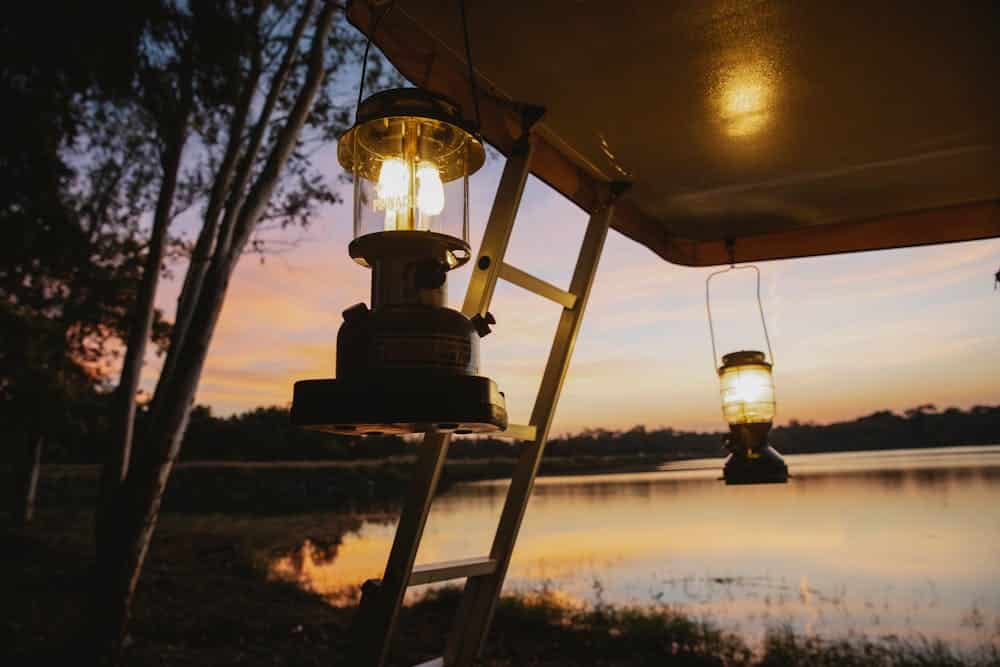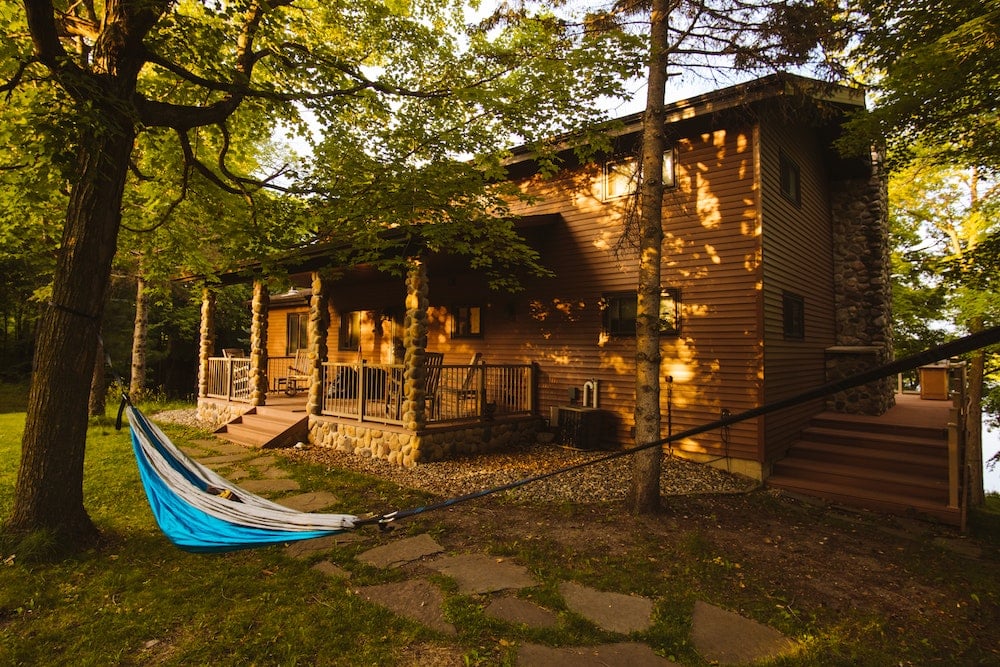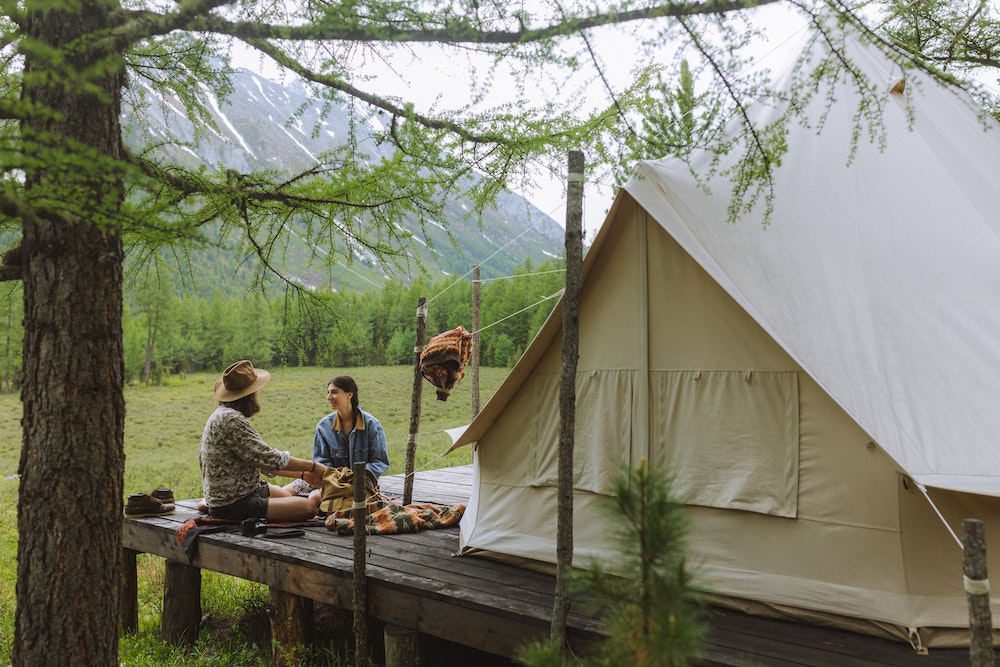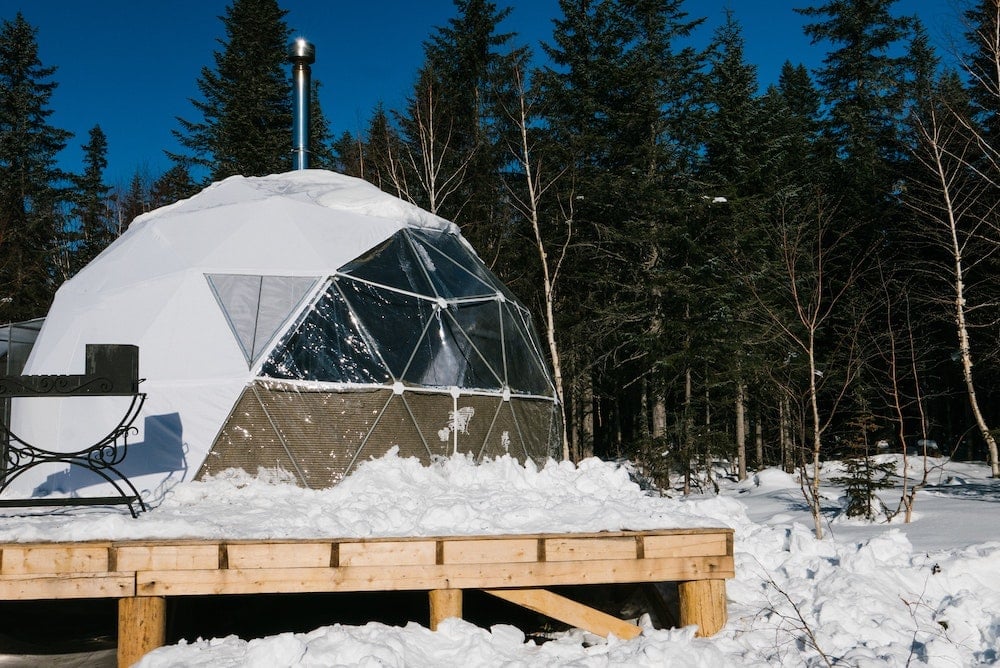As one of the fastest-growing sectors in the vacation rental industry, glamping businesses present an excellent opportunity for aspiring hosts. More and more guests are choosing to book short-term rentals that offer a unique vacation experience, something glamping can provide at an affordable price.
We are seeing this trend throughout the world, with the global glamping market predicted to grow at a compound annual growth rate (CAGR) of 13.9% through 2031. This will bring its global market size to an expected $7,856.23 million by the end of this period.
This growth represents a huge business opportunity for glamping investment, especially as nature getaways continue to increase in popularity.
Don’t see the form to download our glamping business plan template? Click here.
What is a glamping business?
Glamping is, quite literally, the combination of the words “glamorous” and “camping,” and is also referred to as luxury camping. For many, the idea of camping may conjure up memories of being cold and wet in the middle of nowhere with little to no amenities. However, glamping has completely revolutionized this idea, making it an unforgettable experience for even the most trepid traveler.
Imagine being surrounded by nature and tranquility while having access to the comforts of luxury accommodation. Guests can explore the great outdoors and enjoy various activities, from hiking to stargazing, before relaxing in a hot tub and sleeping in comfortable beds.

It doesn’t sound bad, does it? And when it comes to glamping as a business owner, it gets even better.
This is because the investment opportunities are endless. You can start a glamping business pretty much anywhere, as long as it has access to nature. And depending on the accommodation type, you can attract guests throughout the year.
What is a glamper?
As we’d describe people who go camping as campers, “glampers” are what we call glamping guests. These travelers are unique as they’re looking for an off-grid experience without sacrificing the comforts of a standard vacation rental. Therefore, you’ll have to appeal to your target customer by emphasizing your property’s proximity to nature and highlighting the amenities you offer.
As glamping is a niche market, ensuring your business’s sustainability will require you to understand who intends to stay at your property.
Who goes glamping?
Younger guests
Glamping is especially popular among 18-32-year-olds, with experts citing several reasons for this. Firstly, it’s fashionable, and the aesthetics of glamping make it perfect for social media. Secondly, music festivals have started to include glamping as a more comfortable choice of overnight accommodation.
In addition, there is an increasing awareness of the importance of environmental protection and sustainability. Most glamping structures are built using low-impact materials, including upcycled and natural products, making them appealing to eco-conscious travelers.

The rise in popularity of wellness and wellness tourism means glamping is in demand for guests looking to participate in activities such as yoga and forest bathing.
Families
Beyond Millenials and Gen-Z, families have also taken to glamping. They see being in nature as an opportunity to bond and share quality time together away from work, cell phones, and video games.
Luxury camping is for everyone
Although younger guests make up the majority of the market share, glamping is attractive to a variety of age groups, which helps to support the argument for investment. According to the most recent data, guests in the 33-50 age group will have the second-fastest CAGR.
Are glamping businesses profitable as vacation rentals?
So, is glamping a good investment? This should be your biggest concern before starting your business. The idea of putting money into something trendy could make buyers concerned, and rightfully so.
Fortunately, glamping’s popularity isn’t so fleeting. Since its rise to fame in the late 2000s, glamping has become a travel trend that seems here to stay. Taking this into account, along with its relatively low startup costs, it’s realistic to expect a quick ROI.

How much does it cost to start a glamping business?
The glamping business startup cost varies widely depending on the price of land in your area and the type of accommodations you choose to offer.
While you may be tempted to invest in the cheapest land you can find, remember that location is everything for glamping. Picturesque surroundings and proximity to local outdoor attractions will go a long way toward attracting guests and maximizing your nightly rates. So, a more expensive plot may well be worth it.
Property costs aside, you will need to have at least a few thousand dollars to start your glamping business, assuming you go with a cheaper glamping accommodation option. However, if you hope to provide a more expensive option such as yurts, your accommodations could cost tens of thousands of dollars. Read about the different types of glamping in the next section to learn more.
Additionally, as with any vacation rental business, you’ll have the following costs to take into account as well:
- Furnishings and decor
- Amenities
- Glamping insurance
- Utilities
- Property taxes
- Maintenance and cleaning costs
How much do glamping businesses make?
Similarly, glamping business income depends on a variety of factors, including the type of accommodations you offer.
For example, you can purchase good quality bell tents for as little as $2,000, which are considered low-maintenance compared to a standard vacation rental. High-end luxury camping sites can charge up to $1,000 a night, so running a profitable business might be easier than you think.
In general, revenue potential for glamping businesses ranges from $40,000 to $250,000. This puts glamping business profit around $32,000 to $200,000.
Of course, you’ll have fewer costs in your second year of business, as you won’t have to purchase accommodations and furnishings again. So, your profit will only grow over time!

Types of glamping
The beauty of glamping—for investors and guests—is the wide range of accommodation types available. Hosts can let their imaginations run wild when it comes to the kind of vacation experience they offer.
Cabins and pods are the most common in North America, followed by tents, yurts, and treehouses. However, there are many weird and wonderful examples of glamping options, from domes and pods to Airstreams and upcycled buses.
In the list below, we look at some of the most popular luxury camping categories.
1. Cabins
Of course, the concept of cabins is not new, and they have been around for hundreds, if not thousands, of years. Nevertheless, this is exactly what makes them so intriguing.
The rustic appearance of these log structures is often associated with the North American wilderness, and many can be found within easy reach of the continent’s most impressive national parks, making them ideal for glamping.
2. Pods
Pods are typically made from wood and are designed to replace traditional camping tents. Their interiors are often simple yet comfortable and can be fitted with electrical appliances and even WiFi.
Notoriously low-maintenance, pods can be built for as little as $3,000, giving hosts a quick ROI, especially when there’s more than one unit on site.
3. Bell tents and tipis
Bell tents are classic glamping structures that provide better weather protection and offer more space than camping tents. They are durable, breathable, and easy to build.
Tipis are traditional Native American tents, but the modern version is constructed from cotton fabric and wooden beams. These triangular-shaped tents are found throughout North American campsites and are especially popular among families with young kids.
Although some may consider these tents too simple to be regarded as luxury camping, there are usually shared amenities outside of the accommodation. Hosts may offer facilities like bathhouses and outdoor kitchens to make up for the lack of amenities inside.

4. Yurts
Originating from Mongolia, yurts are traditional circular tents often found in Central Asia that are made using a lattice of flexible wood and covered in felt. They are typically fitted with patterned rugs, comfortable beds, and a wood-burning stove, and are significantly more spacious than a regular camping tent.
Building a yurt can cost between $7,500 to $64,000, depending on the size, materials used, and amenities you provide.
5. Treehouses
Unsurprisingly, treehouses are made from wood and are normally built within a tree, making use of its organic architecture, or placed in the woods. They are perfect for guests who want a peaceful stay in nature mixed with a bit of adventure.
The options are endless with treehouses. They are particularly popular among couples due to their romantic vibe. Still, if you build expansions or multiple units, you can expect higher profits by marketing your property to families and larger groups.
6. Tiny houses
Tiny houses are one of the most eco-friendly options, as they are designed to take up the minimum amount of space and minimize resources. In addition, many are built with eco-friendly materials.
Typically, vacation rental owners who manage tiny homes have more than one unit on a larger plot of land. The average cost to build a tiny house is between $30,000 and $60,000.
7. Trailers and Airstreams
Retro trailers and Airstreams are hugely popular—and an American icon. Often associated with movie stars, these portable accommodations are not necessarily cheap, but they certainly boast longevity.
Hosts can add outdoor seating and barbecues to create an ambient exterior setting.

8. Domes
A dome is a transparent pod that usually comes with just a bed in its most basic form. Glampers love these structures because they can enjoy sunrises and stargaze from the comfort of their pillows.
Ideal for romantic getaways, domes can cost anywhere between $3,000 and $14,000.
9. Railroad cars
While railroad cars will certainly be hard to obtain, if you’re able to locate them, you’ll have a highly unique experience to offer your guests. Remodel their interiors to create comfortable and attractive accommodations that your guests will love.
Why should you start a glamping business?
Hosts have different reasons for starting a glamping business, and not all of them do it purely for profit. There’s no doubt that glamping can be a lucrative business. However, many do it for their love of nature, the lifestyle, or simply as a side hustle as they tend to their land.
Whatever your reasons are, here’s why you should start a glamping business.
1. Glamping is an unforgettable experience
Glamping opens doors to a whole new group of travelers. The idea of traditional camping puts many people off: the cold, mosquitoes, no running water, no access to fresh food, etc.
However, glamping is a completely different ball game. Providing a comfortable and unique vacation in the great outdoors will allow inexperienced travelers the opportunity to connect with nature.
Many vacation rentals offer more exclusive extras, such as welcome packs, yoga classes, rustic breakfasts, organic farming experiences, and animal petting areas.
Whether you market your vacation rental to couples, families, or large groups, it’s bound to be an unforgettable experience with long-lasting memories made.

2. Eco-friendly and luxurious
As both luxury and sustainable tourism trends surge, hosts have the opportunity to invest in an eco-friendly vacation industry—and their guests will love them for it!
Installing solar panels and eco-toilets while using recycled and organic materials will allow you to offer the experience guests want while lowering your carbon footprint.
3. Lower investment and higher profits
The initial investment for glamping isn’t as high as buying a house and having to take out a mortgage. Rather, it is a lot cheaper to build, manage, and run. Therefore, the profit should be higher, and you should get your return on investment in a shorter amount of time.
The key is to get your glamping vacation rental out on the market. Know how to target your vacation rental to certain types of travelers, such as fitness and wellness travelers and millennials. Be aware of SEO hacks to ensure guests find your vacation rental on the most popular OTAs.
Today, glamping is considered a profitable business and can be managed in the same way as any other type of short-term rental.
4. Glamping is for everyone
Even though the younger generation makes up nearly 50% of the market share, each age group is growing year by year, demonstrating that glamping is for everyone.
You can tailor your marketing approach to target specific age groups while installing appropriate facilities to match.
5. Weddings and events
Glamping isn’t restricted to local campsites. As an investor, you could decide to cater to the increasing rise in glamping weddings and music festivals. You can capitalize on these notoriously profitable events by offering unique and luxurious experiences for a relatively low starting cost.
6. Running a glamping business is fun!
The opportunity to be your own boss, earn an income, and be surrounded by nature is appealing to many would-be hosts. It can be a hugely rewarding experience tending to your land while welcoming all kinds of people.
Reading the reviews from guests on luxury camping listings and speaking to fellow glamping hosts will tell you all you need to know about how fun it can be!
Starting a glamping business
The great news is that it’s relatively easy to open a glamping business considering the lower startup costs and the minimal build time. However, a successful glamping business still needs some strategizing.
Glampers have a good radar for what makes a glamping site different from a typical campsite, so you have to carefully plan out your short-term rental business if you’re going to convince potential guests.
Create a glamping business plan
Would you undergo any major investment without a structured idea of where you’re headed? Of course not! Glamping is no exception. Many vacation rental owners are wrongly misled to believe it’s too easy to own a glamping business. While it can be a lower commitment, planning is still imperative.
A good example of a business plan for glamping would include a company and industry analysis, an operations plan, and revenue management, at a minimum.
Still not sure how to write your glamping business plan? We’ve got you covered with our glamping business plan example.

Business loans for glamping
It’s not a plot of land and it’s certainly not a hotel, so what is it? In the eyes of lenders, glamping can be hard to categorize. It’s important to find the right loan for your glamping endeavor to avoid excessively high interest rates or extended timelines for paying it back. Read up on all the tips for financing so you don’t end up paying more than you have to.
Your own bank
This might be your best option if you have a good relationship with your bank. Good rapport goes a long way with lending, as most lenders are seeking reliable borrowers.
Local banks and credit unions have it in their best interest to lend to their local residents, so see what options they could offer you. Also, you give back to your community and stimulate the local economy—so it’s a win, win!
Secured loans
If you already have other assets you could put on the line as a “security” to get a loan, this might be a good option. This is especially beneficial for vacation rental owners who already have other properties. Your existing asset might help you secure a good loan.
Startup loans
Due to its unconventional nature, some lenders don’t view a glamping business as a property investment so much as a startup business. In some cases, you can secure a loan under the “startup” category with better terms and conditions than a property loan may offer you.
Building a glamping site
Your construction is going to vary depending on a number of factors. No two glamping businesses are created equal, nor should they be! Glamping is acclaimed for its uniqueness, so each build is going to be entirely different. Still, there are some factors to consider regardless of how you decide to create your glamping business.

Permits
Many sites are heavily safeguarded by governing authorities. Protected land and building permits can make the construction of a “glampsite” difficult.
Be on the lookout for land with an easements clause. Essentially, this means that certain parameters over your property (like road access, a septic system, or hooking up to an electrical grid) would require additional access outside of your property, like a private road on your neighbor’s land. You could find yourself purchasing land that can’t be converted into a glamping site if you’re not careful.
Zoning restrictions
Zoning laws are great for when you don’t want a busy highway at your doorstep, but they’re less than ideal when you’re trying to start a vacation rental business. There are many zoning regulations, especially for highly touristic areas, that would prevent you from building your glamping business on some plots of land.
If you’re using a realtor or real estate site, make sure you’re filtering out zoning options that wouldn’t allow a glamping site to be built.
Purpose
If you’re dead set on owning a tipi glamping business, you should only consider land that would be feasible for this type of accommodation. The same is true for any other type of glamping stay. If you want to offer bubble domes, then a plot of land with heavy light pollution and limited visibility might not be your best option.

If you’re still undecided on what type of glamping accommodation you’ll offer, keep it general with the land you buy. If it’s difficult terrain to build on, has limited access to the main road, or is not suitable for installing a septic or well system, then think again! The more difficult your land is to make it habitable, the longer construction time you’ll have.
For more information, you can learn best practices and stay up-to-date with glamping industry news by joining groups like the American Glamping Association (AGA).
The AGA has over 300 active members who meet weekly to discuss topics such as zoning, permitting, glamping structures, raising capital, and more. The association works to create alignment across the industry as it continues to evolve.
What are the glamping regulations in the United States?
Beyond the zoning and building regulations we covered in the previous section, some parts of the country have been explicit about glamping builds. In most cases, if you’re buying raw land, you’ll have to get approval for the “change of use” as it will go from woodland to a business or rental property, depending on local law.
It’s important to consult with your state and local authorities to understand the specifics. Some land is off-limits for glamping whether it’s protected, zoned differently, or federally recognized aboriginal land.
Outside of the U.S.
Zoning and building laws can drastically vary from country to country. For example, in the Netherlands, you don’t need a building permit for glamping as it’s not considered a “permanent build,” but in the U.K., you would need a permit. Always check your local laws to avoid any future fines, penalties, or legal troubles.
Marketing your glamping vacation rentals
What makes glamping so attractive? The sense of escape, the lure of luxury, and the breathtaking views…now you just have to sell it! Glamping is easy to market thanks to its built-in beauty, widespread popularity, and originality. All that’s left for you, the glamping business owner, is to market it. Know who you’re selling to and create an online marketing plan that caters to your crowd.
There are a number of OTAs that specialize in glamping, including Glamping Hub, Hipcamp, and Glamping.com, and even the larger vacation rental platforms, such as Airbnb, are including glamping in their categories.

Use a glamping management software
If you’ve overcome the hurdles of building a glamping campsite, stuck to your business plan, and marketed to potential guests, now is your time to reap the rewards and rake in all those reservations!
Whether you’re working with one yurt or 20 tiny homes, you’ll need the right tools for your day-to-day business operations. It can become overwhelming to manage reservations, set up a booking calendar, list on multiple sites, and run your business.
Lodgify’s glamping management software provides all the property management tools necessary for running your glamping business. What’s more, Lodgify even integrates with Glamping Hub, the premier online booking platform specializing in nature-based accommodations, to empower glamping hosts with increased visibility and bookings. Glamping Hub offers a curated booking platform, SEO-optimized listings, an integration with Kayak, and a secure payment system.
Download our free glamping business plan
If you’re taking your first steps into the glamping industry, you can download our free glamping business plan template to help you along the way. Owning a glamping business can be both exciting and challenging—but definitely worth it.
Don’t see the form to download our glamping business plan sample? Click here.



